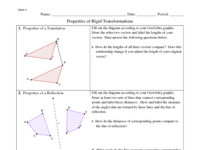9-30-25 Properties of Rigid Transformations
Use the applet below to answer the following questions: [br][br][b]a.[/b] What do all three angles in the triangle add up to? Does this seem to remain true if you change the size and shape of the triangle? [br][br][b]b.[/b] Will this sum above always be true? Use the [i]Rotation[/i] icons to investigate this fact. [br][br]*If you right click on any unlabeled angles you can see the angle measures.
[b]a. [/b] Translate triangle [i]ABC[/i] along the vector that takes [i]B[/i] to [i]G[/i]. [br] **Select the vector tool [icon]https://www.geogebra.org/images/ggb/toolbar/mode_vector.png[/icon] and draw a vector starting at point [i]B[/i] and ending at point [i]G[/i]. Then, select the translate by vector tool [icon]https://www.geogebra.org/images/ggb/toolbar/mode_translatebyvector.png[/icon], click on triangle [i]ABC[/i], and then click on the vector.[br][br][b]b. [/b] Draw another vector from point [i]A[/i] to A'[i], [/i]and from [i]C [/i]to [i]C'[/i]. You should now have three sets of vectors, each connecting a pair of corresponding points. Measure the distance of each vector by using the distance measuring tool [icon]/images/ggb/toolbar/mode_distance.png[/icon], and selecting each pair of corresponding points (as an example, click on [i]A[/i] followed by [i]A'[/i] with the tool selected).
[b]a. [/b]Reflect quadrilateral [i]ABCD[/i] over line [i]v. [br] *[/i]Select the reflect about line tool [icon]https://www.geogebra.org/images/ggb/toolbar/mode_mirroratline.png[/icon], click on quadrilateral [i]ABCD[/i], then select line [i]v[/i]. [br][b]b. [/b]Pick two pairs of corresponding points, say [i]B[/i] and [i]B'[/i], and [i]C[/i] and [i]C' [/i]and draw a line segment [icon]/images/ggb/toolbar/mode_segment.png[/icon] between them. Select the point tool [icon]/images/ggb/toolbar/mode_point.png[/icon], and mark each intersection point formed between the line of reflection and your lines connecting your corresponding points. [br][br][br][b]c.[/b] Measure the distance from the line of reflection to each pair of corresponding points using the distance tool [icon]/images/ggb/toolbar/mode_distance.png[/icon]. As an example, you are measuring the distance from the line of reflection to [i]B[/i] and the distance from the line of reflection to [i]B'. [/i] [br][br][b]d. [/b]Pick one of your lines connecting a pair of corresponding points, and measure the angle formed between that line and your line of reflection using the angle measure tool [icon]/images/ggb/toolbar/mode_angle.png[/icon]. [br]
[b]a. [/b] Rotate triangle [i]ABC[/i] around point [i]P[/i] 75 degrees counterclockwise. [br][br] *[i]*[/i]Select the rotate around point tool [icon]https://www.geogebra.org/images/ggb/toolbar/mode_rotatebyangle.png[/icon], click on triangle [i]ABC[/i], then click on point [i]P[/i]. Type in an angle of 75 degrees, and select counterclockwise. [br][br][b]b. [/b] Draw a line segment from [i]C[/i] to point [i]P[/i]. Then, draw a line segment from [i]C[/i]' to[i] P. *[/i]You can use any pair of corresponding points, it does not have to be [i]C[/i] and [i]C'[/i].[br][br][b]c. [/b]Measure the angle formed using the angle measuring tool [icon]/images/ggb/toolbar/mode_angle.png[/icon]. [br][br][b]d. [/b] Measure the distance from [i]P[/i] to your two corresponding points using the distance tool [icon]/images/ggb/toolbar/mode_distance.png[/icon]. [br][br][b]e. [/b] Rotate triangle [i]ABC [/i]around point [i]P[/i] again, this time using an angle measure of your choosing. Repeat steps [b]b-d[/b] again, and see if the same relationships hold true. [br][br]
[b]a.[/b] Determine where the line of reflection is located to map triangle [i]ABC[/i] on to triangle [i]XYZ.[br][br][/i]i. Start by drawing the line of reflection using the [i]Line[/i] tool [icon]/images/ggb/toolbar/mode_join.png[/icon]. [br][br]ii. Use the [i]Reflect about Line[/i] tool [icon]/images/ggb/toolbar/mode_mirroratline.png[/icon], select triangle [i]ABC[/i] then your line of reflection. If you are correct, you should now see triangle [i]A'B'C''[/i] mapped on to triangle [i]XYZ[/i]. If not, adjust your line of reflection until [i]ABC[/i] is mapped on to [i]XYZ[/i].
[b]a.[/b] Determine where the line of reflection is located to map quadrilateral [i]ABCD[/i] on to quadrilateral [i]WXYZ.[br][/i]i. Start by drawing the line of reflection using the [i]Line[/i] tool [icon]https://www.geogebra.org/images/ggb/toolbar/mode_join.png[/icon]. [br]ii. Use the [i]Reflect about Line[/i] tool [icon]/images/ggb/toolbar/mode_mirroratline.png[/icon], select [i]ABCD[/i] then your line of reflection. If you are correct, you should now see quadrilateral [i]A'B'C'D'[/i] mapped on to quadrilateral [i]WXYZ[/i]. If not, adjust your line of reflection until [i]ABC[/i] is mapped on to [i]XYZ[/i].
[b]a.[/b] Determine the number of degrees, direction, and the location of the center of rotation to map triangle [i]ABC[/i] on to triangle [i]WXY[/i]. [br][br]i. Start by plotting a point for your center of rotation. [br][br]ii. Using the [i]Rotate around Point [/i]tool [icon]/images/ggb/toolbar/mode_rotatebyangle.png[/icon], select [i]ABC [/i]then your center of rotation. Type in the number of degrees for the rotation and whether the rotation is clockwise or counterclockwise. If you are correct, you should now see triangle [i]A'B'C'[/i] mapped on to triangle [i]XYZ[/i]. Adjust your center of rotation and the number of degrees appropriately if [i]A'B'C'[/i] is not mapped on to [i]XYZ[/i].
[b]a.[/b] Determine the number of degrees, direction, and the location of the center of rotation to map quadrilateral [i]ABCD[/i] on to quadrilateral [i]WXYZ. [/i][br][br]i. Start by plotting a point for your center of rotation. [br][br]ii. Using the [i]Rotate around Point [/i]tool [icon]/images/ggb/toolbar/mode_rotatebyangle.png[/icon], select then your center of rotation. Type in the number of degrees for the rotation and whether the rotation is clockwise or counterclockwise. If you are correct, you should now see quadrilateral [i]A'B'C'D'[/i] mapped on to quadrilateral [i]WXYZ[/i]. Adjust your center of rotation and the number of degrees appropriately if [i]A'B'C'D' [/i]is not mapped on to [i]WXYZ[/i].
Experiment with each set of reflections and rotations. Are their certain sets of transformations that seem to place the image of quadrilateral [i]ABCD[/i] in the same location?
